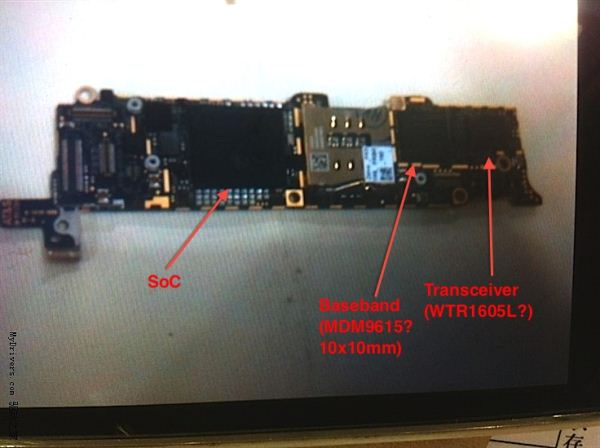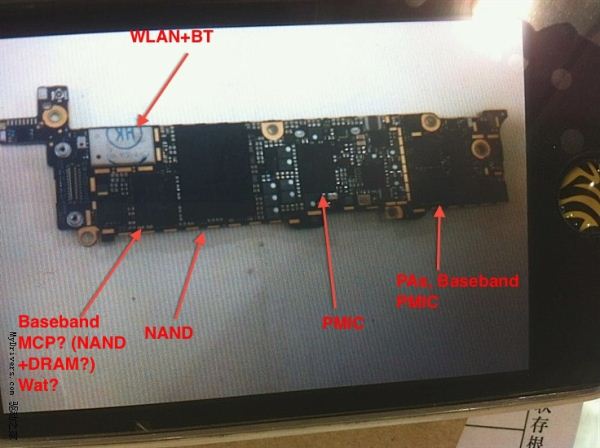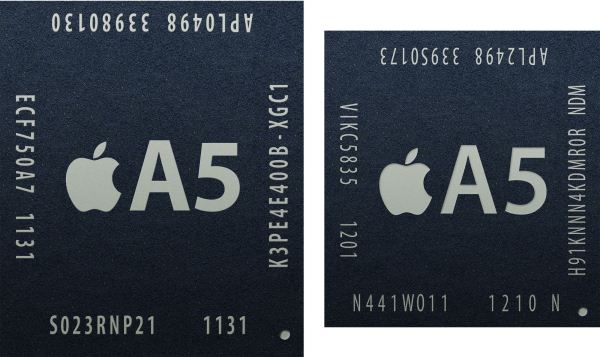Preparing for the iPhone Next: Rumors Analyzed
by Brian Klug & Anand Lal Shimpi on August 27, 2012 9:40 PM EST- Posted in
- Smartphones
- Apple
- Mobile
- iPhone
The SoC: 32nm A5R2?
So much of any new iPad/iPhone release is tied to the SoC. Apple remains one of the only handset designers that aggressively specs its own SoC rather than picking up an off the shelf part. As of late, Apple has used its control over its own SoC architecture to better match its chip architectures to the needs of its high resolution displays. Apple continues to produce its custom-designed SoCs at Samsung, although it's likely that Apple will consider other foundries at the 20nm node.


Rumored upcoming PCB, annotations ours
Most early looks at the next iPhone's internals show no silkscreened part numbers on the SoC. We've already seen blurry photos of the suspected upcoming PCB leak, though they're far too low quality to make out any chip markings. Given Apple's history, it's likely we'll see a 32nm LP (HK+MG) variant of the A5 SoC used in the iPhone 4S - perhaps at higher clocks. The move to a smaller process node should bring about a tangible increase in battery life. Depending on the workload, the iPhone 4S could burn more power than the iPhone 4 thanks to its beefy CPU + GPU combination. The move to 32nm could easily offset this penalty.
We've seen Apple experiment with Samsung's 32nm LP process in the past. Both the current generation Apple TV and the iPad 2,4 use a 32nm A5. In the case of the iPad 2,4, we saw a huge increase in battery life as a result of the move to 32nm. Some of the gains in battery life in the iPhone are likely to be offset by higher CPU/GPU clocks, but this is still the most likely approach for Apple this generation.

Original A5 (45nm, S5L8940, left), A5R2 (32nm, S5L8942, right)
As we mentioned back during our review of the iPad 2,4, it makes sense to test a new/unfamiliar process on a low volume part. By shipping 32nm A5 SoCs into some iPad 2s and the Apple TV (a hobby product), Apple could ride the 32nm yield curve up without adversely impacting shipments of its key money makers. With Samsung's 32nm LP process likely seeing much better yields now, it's time to deploy it in the next iPhone. Given much of the competition has moved to TSMC's 28nm process, Apple must remain competitive on the process node front as well. Shipping a 45nm SoC at the end of 2012 simply doesn't make sense. Although the current legal battles with Samsung could impact the relationship on the foundry side, simply switching to Global Foundries or TSMC is easier said than done. I would expect Apple to go through the same careful transition between Samsung and any other foundry as it did when it introduced the first 32nm A5s into the mix. The current expectations here are that we'll see Apple look at TSMC at the 20nm node.
With process node pretty much guaranteed, there's the question of CPU and GPU architectures.
Since the release of the original iPad, Apple has used the spring to introduce new SoC architectures in the iPad and later waterfall them down to the iPhone in the summer/fall. The A5X in the 3rd generation iPad however is still built on Samsung's 45nm LP process and is huge as a result of integrating four PowerVR SGX543 cores and implementing a 4 x 32-bit memory interface. The A5X needed the GPU power and memory bandwidth to drive the new iPad's retina display, but that power would be largely lost on the next iPhone.
The new iPhone is expected to have a 640 x 1136 resolution, thanks to its taller 4-inch display, but that's only 18% more pixels than the current iPhone 4S. A doubling of memory bandwidth and GPU compute horsepower would seem a bit excessive for current workloads. A ~20% increase in GPU clock speed, and faster DRAM would be enough to maintain current levels of performance on the higher resolution display.
Apple decoupled major cellular architecture and CPU architecture shifts in the past (e.g. iPhone 3G/3GS transition), which lends credibility to the idea of a move to A15 next year with the 4th gen iPad and sticking with the dual-core A9 design for the next iPhone. There's also the fact that TI is expected to be one of the first to bring an ARM Cortex A15 based SoC to market, and even it hasn't demonstrated an OMAP 5 running at shipping CPU clocks yet. I don't doubt that it's possible to ship an A15 based SoC before the end of the year, but based on the demos we've seen thus far, it seems highly unlikely to see one shipping in Q3. Apple doesn't like to be overly risky on the component front. There's nothing worse than a poorly yielding or otherwise problematic chip holding up shipments of one of your biggest revenue generators.










131 Comments
View All Comments
gilesrulz - Tuesday, August 28, 2012 - link
You're admittedly not an Apple user or a future Apple user, so why would Apple build a phone for you?While there may be a small population that share your desire for NFC and mobile payments generally, for most it is a solution looking for a problem (at least in the US - I have read interesting use cases for the developing world).
As for the proprietary port, there was an exception put into the law that allows for adapters to USB, which is what Apple has bee providing since the law went into effect.
alxx - Tuesday, August 28, 2012 - link
NFC I'd prefer not to have until the security bugs are worked out it.Personally I prefer a phone that fits in my pocket (shirt and pants) and doesn't need a bag or belt clip to carry it
mantikos - Tuesday, August 28, 2012 - link
Stop the hobby product BS, its a failed product...there is nothing known as a hobby product...if Surface flops tomorrow, would you be kind enough to call it just a 'prime the pump' product because MSFT called it that?!gilesrulz - Tuesday, August 28, 2012 - link
The have sold more than 4.2 million of them (2nd Gen). It is not a "failed product" or a "flop".jamyryals - Tuesday, August 28, 2012 - link
Exactly right, it's only a hobby product for Apple because in comparison to their other revenue streams it's tiny. For almost any other companies selling 4 million of anything would be a huge success. I bet Google wishes they'd sold even 1 million Qs.KoolAidMan1 - Tuesday, August 28, 2012 - link
How is it failed? It sells more than the XBox 360, that's pretty successful for a consumer gadget.It may be a hobby compared to an iPhone or iPad, but anything else is small in comparison. The iPhone alone makes more revenue and profit than Windows and Office combined.
Doormat - Tuesday, August 28, 2012 - link
Any word on whether its feasible for IGZO screens or not? 50-90% lower power consumption.swb311 - Tuesday, August 28, 2012 - link
IGZO is not for mobile right now. It's using In-Cell which might be confusing. IGZO is a replacement or different type of LCD which may end up in an eventual iTV or newer iMacs but definitely not in phones any time soon.HisDivineOrder - Tuesday, August 28, 2012 - link
Please, please let them update the iPod Touch. It's beyond long in the tooth. Hell, I won't mind if they discontinue the iPod Touch line in favor of an iPad Mini line that is essentially the same thing at the same 4" diagonal of the iPhone, put the 7" iPad in as an iPad Air, and let the iPad become the Big-Daddy Pro of the iPad lineup.Ethaniel - Tuesday, August 28, 2012 - link
I agree, I would love to see the iPod Touch updated, but no, I don´t want them to discontinue it. You have 90 percent of the iPhone´s functions without having to put a provider´s "ball and chain" in your ankle... oh, wait...My point is, I want a "tablet" that fits in my pocket. The closest thing so far without breaking the bank where I live is the current iPod Touch. If there are no updates, I guess I´ll grab the current gen.